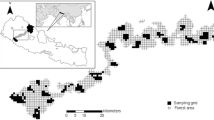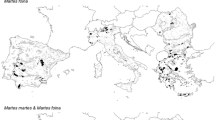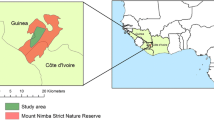Abstract
This study was conducted to analyze the habitat preference of six major mammals for various environmental factors based on 100 random points within a mountain area in South Korea. In-situ presence and absence data for the mammals were surveyed and collected, and twelve explanatory variables related to topography, water, greenness, and anthropogenic influence were applied to create a habitat distribution model. The best combination of variables was determined using Moran’s I coefficients and Akaike criteria information, and applied to estimate the habitat preference for each species using GRASP v.3.0. The predictive map showed that wildlife animals in this study were mainly categorized into two groups: Group I (Korean squirrel, Sciurus vulgaris, mole, Talpa micrura and water deer, Hydropotes inermis), showed equal preference for all mountainous areas; Group II (weasel, Mustela sibirica, leopard cat, Felis bengalensis and raccoon dog, Nyctereutes procyonoides) showed different preferences in a mountain.
Similar content being viewed by others
References
Akaike, H., A new look at the statistical model identification, IEEE Trans. Autom. Contrib., 1974, vol. 19, pp. 716–723.
Andrén, H., Effect of habitat fragmentation on birds and mammals in landscapes with different proportions of suitable habitat: a review, Oikos, 1994, vol. 71, pp. 355–366.
Aspinall, R. and Veitch, N., Habitat mapping from satellite imagery and wildlife survey data using a Bayesian modeling procedure in a GIS, Photogramm. Eng. Remote Sens., 1993, vol. 59, pp. 537–543.
Austin, M.P., Spatial prediction of species distribution: an interface between ecological theory and statistical modeling, Ecol. Model., 2002, vol. 157, pp. 101–118.
Brotons, L., Thuiller, W., Araújo, M.B., and Hirzel, A.H., Presence-absence versus presence-only modeling methods for predicting bird habitat suitability, Ecography, 2004, vol. 27, pp. 437–448.
Burnham, K.P. and Anderson, D.R., Kullback-Leibler information as a basis for strong inference in ecological studies, Wildl. Res., 2001, vol. 28, pp. 111–119.
Cornwell, W.K. and Ackerly, D.D., Community assembly and shifts in plant trait distributions across an environmental gradient in coastal California, Ecol. Monogr., 2009, vol. 79, pp. 109–126.
Dangjin City, The Statistical Yearbook in 2014, Dangjin, 2014.
Darveau, M., Beauchesne, P., Bélanger, L., Huot, J., and Larue, P., Riparian forest strips as habitat for breeding birds in boreal forest, J. Wildl. Manage., 1995, vol. 59, pp. 67–78.
De Alba, S., Lindstrom, M., Schmacher, T.E., and Malo, D.D., Soil landscape evolution due to soil redistribution by tillage: a new conceptual model of soil catena evolution in agricultural landscapes, Catena, 2004, vol. 58, pp. 77–100.
Dubayah, R. and Rich, P.M., Topographic solar radiation models for GIS, Int. J. Geogr. Inf. Syst., 1995, vol. 9, pp. 405–419.
Eldridge, M.D.B. and Pearson, D.J., Black-footed rock wallaby Petrogale lateralis, in The Mammals of Australia, van Dyck, S.M. and Strahan, R., Eds., Sydney: New Holland, 2008, pp. 376–380.
Elith, J. and Burgman, M.A., Habitat models for population viability analysis, in Population Viability in Plants, Brigham, C.A. and Schwanz, M.W., Eds., New York: Springer-Verlag, 2003, pp. 203–235.
Elith, J., Graham, C.H., Anderson, R.P., Dudik, M., Ferrier, S., Guisan, A., Hijmans, R.J., Huettmann, F., Leathwick, J.R., Lehmann, A., Li, J., Lohmann, L.G., Loiselle, B.A., Manion, G., Moritz, C., et al., Novel methods improve prediction of species’ distributions from occurrence data, Ecography, 2006, vol. 29, pp. 129–151.
Fahrig, L., Effect of habitat fragmentation on the extinction threshold: a synthesis, Ecol. Appl., 2002, vol. 12, pp. 346–353.
Ferrier, S., Watson, G., Pearce, J., and Drielsma, M., Extended statistical approaches to modeling spatial pattern in biodiversity in northeast New South Wales. I. Species-level modeling, Biodiversity Conserv., 2002, vol. 11, pp. 2275–2307.
Ferrier, S. and Guisan, A., Spatial modeling of biodiversity at the community level, J. Appl. Ecol., 2006, vol. 43, pp. 393–404.
Franklin, J., McCullough, P., and Gray, C., Terrain variables used for predictive mapping of vegetation communities in southern California, in Terrain Analysis: Principles and Applications, Wilson, J.P. and Gallant, J.C., Eds., New York: Wiley, 2000.
Franklin, J., Mapping Species Distributions: Spatial Inference and Prediction, New York: Cambridge Univ. Press, 2010, pp. 123–124.
Friston, K.J., Holmes, A.P., Worsley, K.J., Poline, J.B., Frith, C.D., and Frackowiak, R.S.J., Statistical Parametric Maps in functional imaging: a general linear approach, Hum. Brain Mapp., 1995, vol. 2, pp. 189–210.
Gibbons, J.W., Terrestrial habitat: a vital component for herpetofauna of isolated wetlands, Wetlands, 2003, vol. 23, pp. 630–635.
Gormley, A.M., Forsyth, D.M., Griffon, P., Lindeman, M., Ramsey, D.S., Scroggie, M.P., and Woodford, L., Using presence-only and presenceabsence data to estimate the current and potential distributions of established invasive species, J. Appl. Ecol., 2011, vol. 48, pp. 25–34.
Grillet, P., Cheylan, M., Thirion, J., Doré, F., Bonnet, X., Dauge, C., Chollet, S., and Marchand, M.A., Rabbit burrows or artificial refuges are a critical habitat component for the threatened lizard, Timon lepidus (Asuria, Lacertidae), Biodiversity Conserv., 2010, vol. 19, pp. 2039–2051.
Grimbacher, P.S. and Catterall, C.P., How much do site age, habitat structure, and spatial isolation influence the restoration of rainforest beetle species assemblages? Biol. Conserv., 2007, vol. 135, pp. 107–118.
Guisan, A. and Zimmermann, N.E., Predictive habitat distribution models in ecology, Ecol. Model., 2000, vol. 135, pp. 147–186.
Guisan, A. and Thuiller, W., Predicting species distribution: offering more than simple habitat models, Ecol. Lett., 2005, vol. 8, pp. 993–1009.
Hastie, T. and Tibshirani, R., Generalized Additive Models, London: Chapman and Hall, 1990.
Hernandez, P.A., Graham, C.H., Master, L.L., and Albert, D.L., The effect of sample size and species characteristics on performance of different species distribution modeling methods, Ecography, 2006, vol. 29, pp. 773–785.
Kim, J.Y., Seo, C.W., Kwon, H.S., Ryu, J.E. and Kim, M.J., A study on the species distribution modeling using national ecosystem survey data, Environ. Impact Asses., 2012, vol. 21, pp. 593–607.
Koenig, W.D., Spatial autocorrelation of ecological phenomena, Trends Ecol. Evol., 1999, vol. 14, pp. 22–26.
Kullback, S. and Leibler, R.A., On information and sufficiency, Ann. Math. Stat., 1951, vol. 22, pp. 79–86.
Lawton, J.H. and Woodroffe, G.L., Habitat and the distribution of water voles: why are there gaps in a species’ range? J. Anim. Ecol., 1991, vol. 60, pp. 79–91.
Lehmann, A., Overton, J.M., and Leathwick, J.R., GRASP: generalized regression analysis and spatial prediction, Ecol. Model., 2002, vol. 157, pp. 189–207.
Legendre, P., Spatial autocorrelation: trouble or new paradigm? Ecology, 1993, vol. 74, pp. 1659–1673.
Macdonald, D.W., Tew, T.E., and Tod, I.A., The ecology of weasels Mustela nivalis on mixed farmland in southern England, Biologia, 2004, vol. 59, pp. 235–241.
Mace, R.D., Waller, J.S., Manley, T.L., Ake, K., and Wittinger, W.T., Landscape evaluation of grizzly bear habitat in western Montana, Conserv. Biol., 1999, vol. 13, pp. 367–377.
MacKenzie, D.I. and Royle, J.A., Designing occupancy studies: general advice and allocating survey effort, J. Appl. Ecol., 2005, vol. 42, pp. 1105–1114.
Manel, S., Dias, J.M., and Ormerod, S.J., Comparing discriminant analysis, neural networks and logistic regression for predicting species distributions: a case study with a Himalayan river bird, Ecol. Model., 1999, vol. 120, pp. 337–347.
McCollin, D., Forest edges and habitat selection in birds: a functional approach, Ecography, 1998, vol. 21, pp. 247–260.
McCullagh, P. and Nelder, J.A., Generalized Linear Models, London: Chapman and Hall, 1989.
Papiernik, S.K., Schumacher, T.E., Lobb, D.A., Lindstrom, M.J., Lieser, M.L., Eynard, A., and Schumacher, J.A., Soil properties and productivity as affected by topsoil movement within an eroded landform, Soil Tillage Res., 2009, vol. 102, pp. 67–77.
Patz, J.A., Graczyk, T.K., Geller, N., and Vittor, A.Y., Effects of environmental change on emerging parasitic diseases, Int. J. Parasitol., 2000, vol. 30, pp. 1395–1405.
Phillips, S.J., Anderson, R.P., and Schapire, R.E., Maximum entropy modeling of species geographic distributions, Ecol. Model., 2006, vol. 190, pp. 231–259.
Rangel, T.F., Diniz-Filho, J.A.F., and Bini, L.M., SAM: a comprehensive application for spatial analysis in macroecology, Ecography, 2010, vol. 33, pp. 46–50.
Rhim, S.J. and Lee, W.S., Influence of forest fragmentation on the winter abundance of mammals in Mt. Chirisan National Park, South Korea, J. Wildl. Manage., 2007, vol. 71, pp. 1404–1408.
Sakaki, H. and Ono, Y., Habitat use and selection of the Siberian weasel Mustela sibirica coreana during the non-mating season, J. Mamm. Soc. Jpn., 1994, vol. 19, pp. 21–32.
Scott, J.M., Heglund, P.J., Samson, F., Haufler, J., Morrison, M., Raphael, M., and Wall, B., Predicting Species Occurrences: Issues of Accuracy and Scale, Covelo: Island Press, 2002, p. 868.
Thuiller, W., BIOMOD—optimizing predictions of species distributions and projecting potential future shifts under global change, Global Change Biol., 2003, vol. 9, pp. 1353–1362.
Tratalos, J., Fuller, R.A., Warren, P.H., Davies, R.G., Gaston, K.J., Urban form, biodiversity potential and ecosystem services, Landscape Urban Plan., 2007, vol. 83, pp. 308–317.
Vos, C.C. and Chardon, J.P., Effects of habitat fragmentation and road density on the distribution pattern of the moor frog Rana arvalis, J. Appl. Ecol., 1998, vol. 35, pp. 44–56
William, J.R. and Robert, L.B., Wolves and the ecology of fear: can predation risk structure ecosystem? BioScience, 2004, vol. 54, pp. 755–766.
Wisz, M.S., Hijmans, R.J., Li, J., Peterson, A.T., Graham, C.H., Guisan, A., NCEAS predicting species distributions working group, effects of sample size on the performance of species distribution models, Diversity Distrib., 2008, vol. 14, pp. 763–773.
Yackulic, C.B., Chandler, R., Zipkin, E.F., Royle, J.A., Nichols, J.D., Grant, E.H.C., and Veran, S., Presenceonly modeling using MAXENT: When can we trust the inferences? Methods Ecol. Evol., 2012, vol. 4, pp. 236–243.
Zhang, E.D., Teng, L.W., and Wu, Y.B., Habitat suitability evaluation for the Chinese water deer Hydropotes inermis in Yancheng Nature Reserve, China, Acta Theriol. Sin., 2006, vol. 26, pp. 368–372.
Author information
Authors and Affiliations
Corresponding author
Additional information
The article is published in the original.
Rights and permissions
About this article
Cite this article
Kwon, HS., Kim, BJ. & Jang, GS. Modelling the spatial distribution of wildlife animals using presence and absence data. Contemp. Probl. Ecol. 9, 515–528 (2016). https://doi.org/10.1134/S1995425516050085
Received:
Accepted:
Published:
Issue Date:
DOI: https://doi.org/10.1134/S1995425516050085




